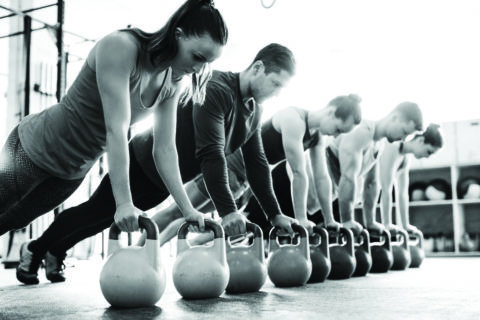3 Fitness Enthusiasts Swear by These Workouts
They might not be trendy, but they really work.
If you’re looking for a new strength training workout, but don’t know where to start, search no further. Here, we break down three tried-and-true workouts that aren’t trendy, but they promise amazing results.
CrossFit
Ballet- and Pilates-inspired workouts are great if you want to build long, lean “beauty” muscles, but thanks to CrossFit, I’ve grown to appreciate the glamour of women who deadlift, pull up and muscle up—and not because the effort will shrink them into perfectly tiny packages of female beauty. No offence to pliés and jetés, but lifting heavy stuff is a rush.
Too many fitness classes operate along strict gender lines, with guys pumping iron in the hope of becoming Captain America-like in one room and women whittling themselves into McDonald’s french fries in another. CrossFit brings the sexes together—almost. “Our membership is about 60 per cent women,” says Rob Sinclair, owner, coach and general manager of CrossFit Solid Ground in Markham, Ont. “For many athletic women, this is an outlet for athleticism that hasn’t existed for them since high school.” It’s also a great place for a non-sporting nerd (I spent my high school career on the sidelines) to live out her wannabe jock dreams.

The workout changes every day (bye-bye, boredom), and you do everything from Olympic-style lifts (deadlifts, squats) to gymnastics (muscle-ups, handstand walks) to rowing, skipping and sprinting—all the while giving it everything you’ve got. One of the biggest pluses for me is that CrossFit doesn’t measure fitness using one standard—for example, cardiovascular endurance or how far you can run—but instead defines it according to a combination of factors, including cardiorespiratory endurance, strength, flexibility, agility and balance. Translation: I track how many reps I complete and the weight I lift, so my gains speak loud and clear.
Though CrossFit has become big business for brand sponsors like Reebok, it has its share of detractors who argue that the focus on high reps and high intensity is a formula for injury. The truth is, injuries do occur. According to a 2013 study published in The Journal of Strength and Conditioning Research, injury rates in CrossFit are similar to those of gymnastics and Olympic weightlifting—both undoubtedly intense sports. I’ve dealt with epic muscle soreness, bruises and barbell-related blisters (the worst!), but I’ve never seriously injured myself. A good gym—you may have to shop around—prioritizes good technique and safety.
Beyond the physical and mental challenges, CrossFit is insanely fun. Getting sweaty and strong and having a laugh with friends while you do it is a nice escape from the mundane, often lonely realities of adult life.
—Flannery Dean
Spinning
Cardio and I haven’t always been friends, but that changed with spinning. Working out solo is a struggle—high-fives to those who fit in those five- and 10-kilometre training runs. But spinning is different; I book a bike and show up. There’s no “I’ll do it later” like with running. Plus, there is a serious calorie burn (an estimated 500 to 700 calories for a 45-minute class). Contrary to popular belief, it’s not all about the legs; you can get a full-body workout. Not only has my cardio improved but spinning classes have gotten better.
Spinning started in Los Angeles back in 1989, when cyclist Johnny Goldberg held the first indoor cycling class in Santa Monica. Since then, spin rooms have been popping up everywhere. But despite its ubiquity, spinning is a trendy subculture of fitness right now. Some classes are candlelit (Montreal’s Spin Énergie, owned by Gilmore Girls’s Yanic Truesdale), while others have DJs spinning a playlist. For the competitive set, there’s The Pursuit by Equinox, which is a video-game-like bike class where your RPMs are used to play against others on a big screen.

Though people have been pondering what will become the “new spinning” for years (when I checked last, it was rowing), spin studios are having a growth spurt. Actually, the membership numbers at boutique fitness studios are growing faster than those of overall gyms, according to business magazine Inc. Within the past year or so, Toronto has seen the opening of a slew of spin studios, including Torq, SpokeHaus, SpinCo, CycleBar and cult-fave SoulCycle.
“Our riders are drawn to the killer workout and also to the community and support they find at our studios,” says Jenna Garofalo, an instructor at SoulCycle in Toronto, which opened on King West this past March and has plans for two more locations this year: Yorkville and Vancouver. “We truly care about what goes on in our riders’ lives outside the studio,” she says. “They are part of the SoulFam.”
—Lisa Hannam
Functional Training
I’m someone who bores easily—let’s just say I was made for ClassPass. But I’ve never seen results—greater strength, more defined muscles—like the ones I’ve gotten with the latest back-to-basics fitness trend: functional movement. This approach is included in some killer classes, like F45, which combines high-intensity interval training, circuit training and functional training into a 45-minute workout (its founder, Luke Istomin, has trained Hugh Jackman and Nicole Kidman), and Animal Flow, which focuses on moves inspired by the animal world that help improve body movements. (The bear crawl, for example, activates just about every muscle in your body at once.)
Put simply, this training regimen incorporates basic exercises into your workout routine, such as squats, that emulate everyday, real-life movements, like getting up off a chair. It’s not the sexiest-sounding term, I’ll admit, but its purpose—to increase mobility while building lean, sculpted bodies—certainly has its perks.

At New York and Los Angeles’s ModelFIT, for instance—a boutique gym that attracts the likes of Karlie Kloss and Chrissy Teigen—functional movement is built into every class. “Our whole method is based on functional movement,” says Vanessa Packer, the founder of ModelFIT and a former fashion stylist-turned-health and fitness entrepreneur. “We train the body to be strong for everyday life: lifting up kids, bending over, stepping down off a curb. It’s about strengthening the small muscles around the big ones so that you’re less likely to get injured. With every movement, there’s a purpose.” The ModelFIT technique breaks down large movements, such as burpees and jump squats, into small ones so that muscles are working at maximum capacity without any strain on the joints. As Packer explains, clients move through multiple planes of motion to target small muscle groups; strengthening these muscles “sculpts and elongates” the body.
In Toronto, fitness instructor Jill Rubenstein-Saltzman teaches strength classes at both Spynga and BOD Studio that include everything from deadlifts to sit-ups. It sounds simple, and that’s because it is. For the first time ever, I’m seeing more benefits from 20 or so minutes of squats and the like done correctly than from 60 minutes of traditional cardio and boot-camp-style classes—which is exactly the point.
In a recent class, I walked across the gym floor carrying 30-pound weights in each hand—a move called “burden walk” that looks easy but is surprisingly sweat- and grunt-inducing. Later that same day, I felt like a rock star as I remembered to keep my chest up and engage my core while lugging crazy-heavy grocery bags into my house.
—Shawna Cohen








